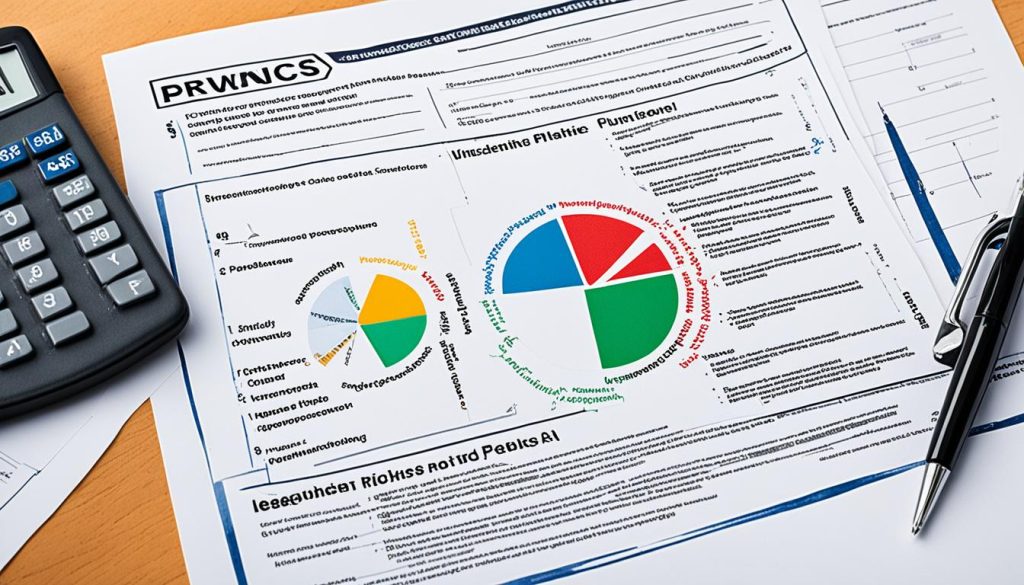When it comes to achieving financial success, having a well-crafted financial strategy is essential. A strong financial strategy enables businesses to navigate the complexities of the financial world and make informed decisions that align with their objectives and goals. It encompasses various components, including thorough market analysis, risk assessment, resource allocation, financial forecasting, cash flow management, and performance metrics. Additionally, flexibility and adaptability are crucial to ensure the strategy can respond to changes in the market.
In this article, we will delve into the critical components of a winning financial strategy and how financial planning and tax services can contribute to your journey towards financial success. By understanding these components and leveraging professional expertise, you can develop a tailored approach that maximizes your chances of long-term prosperity.
Key Takeaways:
- Financial planning and tax services play a vital role in crafting a winning financial strategy.
- Thorough market analysis allows businesses to make informed financial decisions and identify growth opportunities.
- Risk assessment and mitigation strategies are essential to maintain financial stability in the face of unforeseen challenges.
- Effective resource allocation ensures optimal utilization of financial resources to support organizational objectives.
- Financial forecasting and budgeting enable businesses to set realistic goals and monitor progress towards achieving them.
Clear Objectives and Goals
A winning financial strategy begins with a crystal-clear understanding of the organization’s objectives and goals. These serve as the foundation for every financial decision, providing direction and purpose. By setting clear objectives and goals, businesses can align their financial strategy with their desired outcomes and make informed financial decisions.
When it comes to financial decision-making, having clear objectives and goals is crucial. This clarity helps businesses prioritize their initiatives, allocate resources effectively, and make strategic financial choices that align with their overarching vision.
By defining clear objectives and goals, businesses establish a roadmap for success. These goals serve as benchmarks for measuring progress and ensure that financial decisions are made with purpose and intention. Whether it’s achieving long-term profitability, expanding into new markets, or optimizing operational efficiency, having clear objectives and goals provides a framework for effective financial planning.
Additionally, clear objectives and goals enable businesses to communicate their vision internally and externally. This alignment ensures that all stakeholders are on the same page and working towards a common objective. By sharing their objectives and goals, businesses can rally their teams, attract investors, and build trust with customers.
“Setting clear objectives and goals is essential in financial decision-making. It not only gives businesses a sense of direction but also guides resource allocation and informs strategic choices.”
Key Takeaway:
Clear objectives and goals are the bedrock of a winning financial strategy. They provide direction, purpose, and a framework for effective financial decision-making. By setting these goals, businesses can align their financial strategy with their desired outcomes and chart a course towards success.
Benefits of Clear Objectives and Goals
Setting clear objectives and goals in financial decision-making offers several benefits:
- Improved focus and direction: Clear objectives and goals help businesses stay focused on what matters most, making it easier to prioritize initiatives and allocate resources.
- Better financial resource allocation: When goals are clearly defined, businesses can allocate their financial resources more effectively, ensuring that investments are directed towards initiatives that support their objectives.
- Enhanced decision-making: Having clear objectives and goals enables businesses to make informed financial decisions. By aligning choices with their goals, businesses can assess the potential risks and rewards of each decision.
- Increased accountability: Clear objectives and goals provide a basis for measuring performance and holding individuals and teams accountable for their financial decisions and outcomes.
“Clear objectives and goals in financial decision-making drive focus, resource allocation, informed choices, and accountability within an organization.”
Real-World Example: XYZ Company
XYZ Company, a leading provider of technology solutions, experienced remarkable growth by setting clear objectives and goals in their financial decision-making process. They identified three main objectives: increasing market share, improving profitability, and enhancing customer satisfaction.
| Objectives | Strategies |
|---|---|
| Increasing market share | – Expanding into new geographic markets – Investing in marketing and advertising campaigns – Strengthening customer acquisition and retention initiatives |
| Improving profitability | – Optimizing operational efficiency and cost management – Streamlining supply chain processes – Identifying new revenue streams |
| Enhancing customer satisfaction | – Investing in customer service training and infrastructure – Personalizing customer experiences – Implementing feedback mechanisms to gather customer insights |
By aligning their financial decisions with these objectives, XYZ Company was able to make strategic investments, allocate resources wisely, and achieve significant business growth.
“XYZ Company’s success story exemplifies how clear objectives and goals in financial decision-making can drive growth and lead to exceptional results.”
Thorough Market Analysis
Market analysis plays a pivotal role in developing an effective financial strategy. By understanding current market conditions, businesses can gain valuable insights into future trends and potential disruptions. This comprehensive analysis enables informed financial decisions, leading to improved outcomes and opportunities for growth.
During market analysis, organizations assess various factors that impact their industry, including economic indicators, consumer behavior, and competitive landscape. By closely monitoring market trends, businesses can identify emerging opportunities and potential threats, allowing them to stay ahead of the curve and make proactive decisions.
Future trends provide valuable insights into the direction of an industry, helping organizations anticipate changes in customer preferences, technological advancements, and regulatory shifts. By staying informed about these trends, businesses can align their financial strategy with future market dynamics, ensuring long-term success.
Market analysis ensures that organizations are well-prepared to navigate potential disruptions. By identifying potential challenges, such as new competitors, changing regulations, or economic downturns, businesses can develop contingency plans to mitigate risks and maintain financial stability. This proactive approach enables organizations to adapt quickly to unforeseen circumstances, safeguarding their position in the market.
Moreover, market analysis is a cornerstone for making informed financial decisions. By analyzing market data and trends, organizations can allocate resources strategically, invest in areas with high growth potential, and identify untapped opportunities. This data-driven approach enhances the accuracy and effectiveness of financial decision-making, leading to better outcomes.
A thorough market analysis also provides organizations with a holistic view of the competitive landscape. By understanding their position relative to competitors, businesses can identify their unique value propositions, target niche markets, and differentiate themselves from the competition. This valuable insight allows organizations to develop competitive strategies that leverage their strengths and exploit market gaps.
Overall, conducting a thorough market analysis is essential for crafting a winning financial strategy. By staying informed about current market conditions, identifying future trends, and anticipating potential disruptions, organizations can make informed financial decisions that drive growth and ensure long-term success.

Key benefits of thorough market analysis:
- Identification of future trends and potential disruptions
- Enhanced ability to make informed financial decisions
- Improved resource allocation and investment strategies
- Identification of untapped market opportunities
- Competitive advantage through differentiation
- Proactive risk mitigation and contingency planning
- Alignment with market dynamics for long-term success
| Market Analysis Components | Description |
|---|---|
| Industry Research | Thorough examination of the industry’s current state, trends, and growth potential |
| Competitor Analysis | Evaluation of the strengths, weaknesses, and strategies of competitors |
| Customer Insights | Understanding customer preferences, buying behaviors, and unmet needs |
| Market Segmentation | Dividing the target market into distinct segments based on shared characteristics |
| SWOT Analysis | Evaluating the organization’s strengths, weaknesses, opportunities, and threats |
| Trend Analysis | Identification of emerging trends and shifts in the industry |
| Risk Assessment | Identification of potential risks and development of risk mitigation strategies |
Risk Assessment and Mitigation
No financial strategy is complete without a thorough risk assessment. Businesses must proactively identify potential risks that may arise from market fluctuations, operational challenges, or external factors. A comprehensive risk assessment allows organizations to make informed decisions and develop effective contingency plans to mitigate these risks.
“Risk assessment is crucial for businesses to anticipate and navigate unforeseen challenges. By identifying and analyzing potential risks, organizations can proactively implement strategies to minimize their impact and maintain financial stability.”
An effective risk assessment involves a systematic evaluation of various risk factors. This includes assessing the probability of risks occurring, their potential impact on the business, and the timeframe in which they may arise. It also entails analyzing historical data, industry trends, and expert insights to gain a comprehensive understanding of potential risks.
Once risks are identified, businesses can develop risk mitigation strategies tailored to their specific context. These strategies may include implementing backup plans, diversifying investments, allocating resources strategically, and developing contingency plans to address any unexpected challenges that may arise.
It is important to regularly review and update risk assessment processes as risks can evolve over time. By continuously monitoring and reassessing risk factors, businesses can adapt their strategies to effectively navigate changing circumstances.
Benefits of Risk Assessment and Mitigation
A robust risk assessment and mitigation process offer several key benefits to businesses:
- Enhanced decision-making: By understanding potential risks, businesses can make informed financial decisions based on a comprehensive understanding of their potential impact.
- Improved financial stability: Identifying and addressing risks proactively helps maintain financial stability, safeguarding the business against unexpected challenges.
- Strengthened resilience: Having contingency plans in place enables businesses to respond quickly and effectively to unforeseen challenges, minimizing disruption and ensuring continuity of operations.
- Maximized opportunities: Evaluating risks also presents opportunities for businesses to identify and capitalize on market advantages, giving them a competitive edge.
Integrating risk assessment and mitigation into a financial strategy allows businesses to navigate the dynamic and unpredictable nature of the financial landscape. By proactively addressing potential risks, organizations can enhance their overall resilience, stability, and long-term success.

Resource Allocation
Resource allocation is a crucial element when it comes to creating a successful financial strategy. It involves making decisions on how to distribute financial resources across various aspects of the business, including operational expenses, marketing, and research and development. By effectively allocating resources, organizations can ensure that their financial objectives are supported, and they can generate the desired returns.
When it comes to operational expenses, it is important to carefully allocate financial resources to ensure smooth day-to-day operations. This includes expenses related to employee salaries, utilities, equipment, and other necessary resources. By properly managing operational expenses, businesses can maintain stability and productivity while keeping costs under control.
Marketing is another crucial area that requires careful resource allocation. Investing in marketing activities is essential for organizations to raise awareness, attract customers, and generate revenue. By allocating financial resources to marketing initiatives such as advertising, public relations, and digital campaigns, businesses can maximize their brand visibility and reach their target audience effectively.
Research and development (R&D) is an area that plays a vital role in innovation and growth. Allocating financial resources to R&D activities allows businesses to invest in new product development, improving existing offerings, and exploring new opportunities. By prioritizing R&D and allocating resources accordingly, organizations can stay competitive in a rapidly evolving market.
Proper resource allocation is not only about dividing financial resources between different areas of the business, but also about striking a balance. It’s important to carefully assess the needs and priorities of the organization and allocate resources in a way that aligns with the overall financial strategy and objectives.
Effective resource allocation requires ongoing monitoring and evaluation. Businesses should regularly review how financial resources are being allocated and make adjustments as needed. This allows organizations to optimize resource allocation based on changing market conditions and business priorities.

By taking a strategic approach to resource allocation and considering various factors such as financial resources, operational expenses, marketing, and research and development, businesses can ensure that their financial strategy is well-executed and supports their overall objectives. It is a dynamic and iterative process that requires careful analysis and decision-making to maximize the organization’s financial success.
| Area | Importance |
|---|---|
| Operational Expenses | Ensures smooth day-to-day operations and cost control |
| Marketing | Maximizes brand visibility and reaches the target audience |
| Research and Development (R&D) | Drives innovation and growth, staying competitive |
Financial Forecasting and Budgeting
Financial forecasting and budgeting are integral parts of developing a winning financial strategy. These processes allow businesses to predict future financial performance based on historical data and current trends. By analyzing financial information and market factors, organizations can make informed decisions regarding resource allocation and establish realistic financial goals.
Financial forecasting involves estimating future revenues, expenses, and cash flows. It provides insights into how a company’s financial performance might evolve over time, allowing management to anticipate potential challenges and identify growth opportunities. By using financial forecasting techniques, businesses can assess the feasibility of their strategic plans and make adjustments as needed.
To develop an accurate financial forecast, companies typically analyze historical financial statements, market trends, customer behavior, and industry insights. By examining these factors, organizations can gain a clear understanding of their future financial performance and make informed decisions regarding resource allocation.
Budgeting complements financial forecasting by translating the forecasted financial performance into a detailed plan. A budget serves as a roadmap for allocating financial resources based on the organization’s strategic objectives. It helps management set priorities, control spending, and monitor progress towards achieving financial goals.
When creating a budget, businesses consider various factors, including revenue projections, cost estimates, and investment requirements. The budgeting process involves setting realistic financial goals that align with the organization’s long-term vision. By establishing achievable milestones, businesses can track their progress and make informed decisions to ensure financial stability and growth.
One of the key benefits of financial forecasting and budgeting is resource allocation. By understanding future financial performance, organizations can allocate resources effectively and prioritize initiatives that will drive growth and profitability. This process ensures that financial resources are utilized efficiently, minimizing waste and maximizing returns on investment.
An effective financial forecasting and budgeting strategy also promotes accountability and transparency. By establishing clear financial goals and tracking progress, organizations can hold their teams and departments accountable for their financial performance. This fosters a culture of responsibility and ensures that resources are utilized in the most efficient and effective manner.
Benefits of Financial Forecasting and Budgeting
The integration of financial forecasting and budgeting into a comprehensive financial strategy offers several benefits:
- Accurate prediction of future financial performance based on historical data and current trends.
- Optimized resource allocation to support business objectives and drive growth.
- Identification of potential challenges and growth opportunities.
- Control over spending and adherence to financial goals.
- Enhanced accountability and transparency within the organization.
Financial forecasting and budgeting provide businesses with the tools to make informed decisions, set realistic financial goals, and monitor progress towards achieving them. By integrating these processes into their financial strategies, organizations can navigate the volatile and unpredictable nature of the business environment and increase their chances of long-term success.
| Financial Forecasting | Budgeting |
|---|---|
| Predict future financial performance | Translate forecasts into a detailed plan |
| Anticipate potential challenges and opportunities | Set priorities and control spending |
| Optimize resource allocation | Monitor progress towards financial goals |
| Enable informed decision-making | Promote accountability and transparency |

Conclusion
Crafting a winning financial strategy is a multifaceted endeavor that requires careful planning and attention to detail. By incorporating the critical components discussed in this article, businesses can navigate the complexities of the financial world with confidence and chart a course towards financial success.
With expert financial planning and tax services, businesses can tailor their approach to their unique goals and maximize their chances of achieving long-term prosperity. These services provide invaluable support in developing a comprehensive financial strategy that aligns with specific objectives and ensures efficient use of resources.
Whether it’s creating a budget, forecasting future financial performance, or assessing and mitigating risks, a tailored approach is key to achieving financial success. By partnering with trusted financial advisors and leveraging their expertise, businesses can optimize their financial decision-making and stay ahead in today’s competitive business landscape.
FAQ
What is the importance of having a financial strategy?
Why is market analysis crucial for a financial strategy?
How does risk assessment contribute to a financial strategy?
What is resource allocation and why is it important in financial strategy?
What role does financial forecasting and budgeting play in a financial strategy?
How can businesses tailor their financial strategy to their unique goals?
Source Links
- https://www.linkedin.com/pulse/crafting-winning-financial-strategy-c-suite-impact-cfos
- https://www.linkedin.com/pulse/mastering-your-financial-plan-investra-financial-services?trk=organization_guest_main-feed-card_feed-article-content
- https://www.fincircindia.com/mastering-your-startup-finances-a-guide-to-crafting-a-winning-budget/




No comments! Be the first commenter?